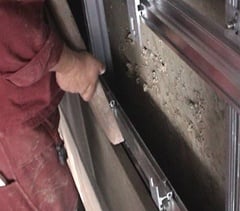PanAsh curtain walling from Stancliffe is a layered system comprising an outer skin of natural stone, a ventilated gap and a waterproof backing wall.
Introduced in 2007, it has panel sizes ranging from 450x300mm up to 750x500mm, with 35-40mm thick stone (other configurations are available on request), depending on the nature of the project. Each panel is independently supported on undercut anchors – and the anchors are one of the clever bits of the design of a fairly clever system.
It was developing PanAsh in the first place that required the effort. Using it does not. Fixings are simply tapped into place. “It’s a piece of cake to put it up,” says Stancliffe’s Warren Goodall. And, of course, that means it goes up quickly.
This system was developed by Stancliffe in conjunction with three partner companies and it has been fully tested to a bespoke testing regime designed by the BRE to ensure its performance throughout a building’s lifespan.
The PanAsh service offered by Stancliffe includes complete technical design, including fixings, and optimisation of module layout and thermal performance. All of this can be covered by a project specific warranty.
PanAsh is lightweight, off the critical path, avoids wet trades and is quick to erect whatever the weather.
PanAsh comes into its own on large areas of flat walling and has now been used on five projects. “Enquiries for this sort of system are very buoyant,” says Warren. “If you want to clad a very rectilinear building it’s great. You lighten the load, increase the floor area, it’s off the critical path, scaffolding costs disappear because you just use scissor lifts, and you can fit out the interior at the same time as the panels are going up.”
Even so, Warren says it is not the ideal solution for all buildings. It is being used on one project at the moment where the lower levels use hand set stone while PanAsh has been used at higher levels where the walls are flat and plane.
“PanAsh is part of our portfolio. When our guys are sitting in front of architects they will assess the best route to go down to achieve the building required. We can supply the right solution for the project – and we are still developing new ways of using stone.”

